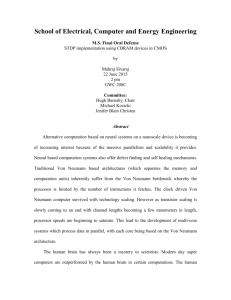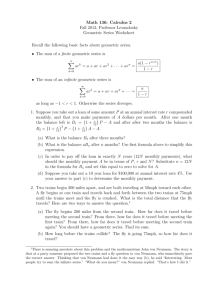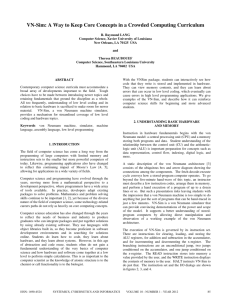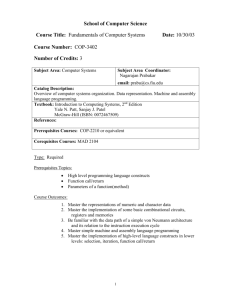Mixing subalgebras of finite von Neumann algebras Jan Cameron Junsheng Fang Kunal Mukherjee
advertisement
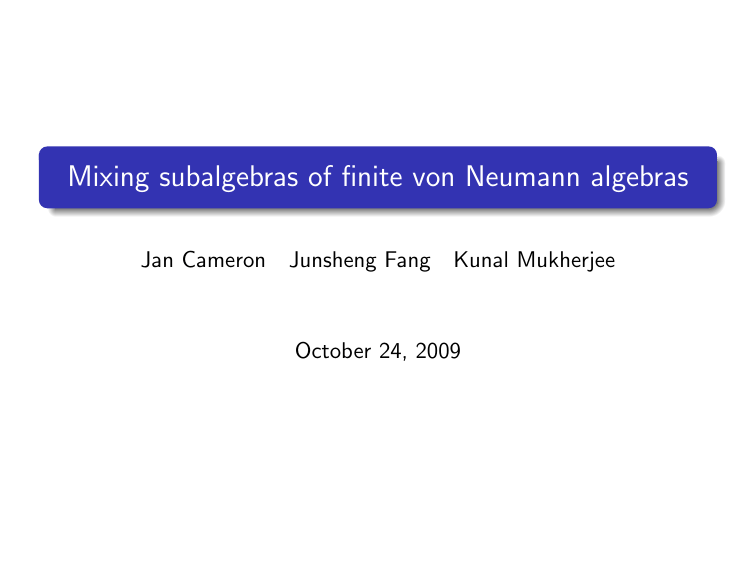
Mixing subalgebras of finite von Neumann algebras
Jan Cameron
Junsheng Fang
Kunal Mukherjee
October 24, 2009
Weak mixing
Theorem (Koopman-von Neumann 1932, etc)
An invertible measure-preserving transformation T on a probability
measure space (X, B, µ) is weakly mixing if
N −1
1 X lim
µ(A ∩ T −n B) − µ(A)µ(B) = 0,
N →∞ N
n=0
∀A, B ∈ B.
Weak mixing
Theorem (Koopman-von Neumann 1932, etc)
An invertible measure-preserving transformation T on a probability
measure space (X, B, µ) is weakly mixing if
N −1
1 X lim
µ(A ∩ T −n B) − µ(A)µ(B) = 0,
N →∞ N
∀A, B ∈ B.
n=0
This condition is equivalent to each of the following conditions:
Weak mixing
Theorem (Koopman-von Neumann 1932, etc)
An invertible measure-preserving transformation T on a probability
measure space (X, B, µ) is weakly mixing if
N −1
1 X lim
µ(A ∩ T −n B) − µ(A)µ(B) = 0,
N →∞ N
∀A, B ∈ B.
n=0
This condition is equivalent to each of the following conditions:
R
for all > 0, f1 , · · · , fn ∈ L2 (X, µ) with X fi (x) dµ(x) = 0,
there exists an n such that |hUTn fi , fj i| < .
Weak mixing
Theorem (Koopman-von Neumann 1932, etc)
An invertible measure-preserving transformation T on a probability
measure space (X, B, µ) is weakly mixing if
N −1
1 X lim
µ(A ∩ T −n B) − µ(A)µ(B) = 0,
N →∞ N
∀A, B ∈ B.
n=0
This condition is equivalent to each of the following conditions:
R
for all > 0, f1 , · · · , fn ∈ L2 (X, µ) with X fi (x) dµ(x) = 0,
there exists an n such that |hUTn fi , fj i| < .
If f ∈ L2 (X, µ) and UT f = λf a.e., then f = const a.e.
Weakly almost periodic functions
Definition
A bounded function f on G is a weakly almost periodic function if
the orbit {Rg f : g ∈ G} is relatively compact with respect to the
weak topology of l∞ (G).
Weakly almost periodic functions
Definition
A bounded function f on G is a weakly almost periodic function if
the orbit {Rg f : g ∈ G} is relatively compact with respect to the
weak topology of l∞ (G).
A coefficient function g → hπ(g)ξ, ηi is a weakly almost periodic
function.
Weakly almost periodic functions
Definition
A bounded function f on G is a weakly almost periodic function if
the orbit {Rg f : g ∈ G} is relatively compact with respect to the
weak topology of l∞ (G).
A coefficient function g → hπ(g)ξ, ηi is a weakly almost periodic
function.
Theorem (Ryll-Nardzewski)
There is a unique G-invariant mean on the set of weakly almost
periodic functions.
Weak mixing
Theorem (Bergelson and Rosenblatt,1988)
G yσg (X, B, µ) is weakly mixing if
M (|hUg f1 , f2 i|) = 0
R
R
for f1 , f2 ∈ L2 (X, µ) with X f1 (x) dµ(x) = X f2 (x) dµ(x) = 0.
Weak mixing
Theorem (Bergelson and Rosenblatt,1988)
G yσg (X, B, µ) is weakly mixing if
M (|hUg f1 , f2 i|) = 0
R
R
for f1 , f2 ∈ L2 (X, µ) with X f1 (x) dµ(x) = X f2 (x) dµ(x) = 0.
This condition is equivalent to each of the following conditions
Weak mixing
Theorem (Bergelson and Rosenblatt,1988)
G yσg (X, B, µ) is weakly mixing if
M (|hUg f1 , f2 i|) = 0
R
R
for f1 , f2 ∈ L2 (X, µ) with X f1 (x) dµ(x) = X f2 (x) dµ(x) = 0.
This condition is equivalent to each of the following conditions
R
for all > 0,f1 , · · · , fn ∈ L2 (X, µ) with X fi (x) dµ(x) = 0,
there exists a g ∈ G such that |hσ(g)fi , fj i| < .
Weak mixing
Theorem (Bergelson and Rosenblatt,1988)
G yσg (X, B, µ) is weakly mixing if
M (|hUg f1 , f2 i|) = 0
R
R
for f1 , f2 ∈ L2 (X, µ) with X f1 (x) dµ(x) = X f2 (x) dµ(x) = 0.
This condition is equivalent to each of the following conditions
R
for all > 0,f1 , · · · , fn ∈ L2 (X, µ) with X fi (x) dµ(x) = 0,
there exists a g ∈ G such that |hσ(g)fi , fj i| < .
{σg } has no finite-dimensional subrepresentations other than the
trivial one.
Finite von Neumann algebras
M is a finite von Neumann algebra with a faithful normal tracial
state τ .
Finite von Neumann algebras
M is a finite von Neumann algebra with a faithful normal tracial
state τ .
For x, y ∈ M , define hx, yi = τ (xy ∗ ) and kxk2 = τ (x∗ x)1/2 .
Finite von Neumann algebras
M is a finite von Neumann algebra with a faithful normal tracial
state τ .
For x, y ∈ M , define hx, yi = τ (xy ∗ ) and kxk2 = τ (x∗ x)1/2 .
L2 (M, τ ) is a separable Hilbert space.
Finite von Neumann algebras
M is a finite von Neumann algebra with a faithful normal tracial
state τ .
For x, y ∈ M , define hx, yi = τ (xy ∗ ) and kxk2 = τ (x∗ x)1/2 .
L2 (M, τ ) is a separable Hilbert space.
Example: L(G) is the von Neumann algebra generated by {Lg }.
Lg δh = δgh , τ (x) = hxδe , δe i.
Cross-product
G yσg (X, B, µ).
Cross-product
G yσg (X, B, µ).
ug (f (x)) = f (σg−1 (x)) for f ∈ L2 (X, µ).
Cross-product
G yσg (X, B, µ).
ug (f (x)) = f (σg−1 (x)) for f ∈ L2 (X, µ).
On l2 (X, µ) ⊗ l2 (G), there are two classes operators Mf ⊗ 1 and
ug ⊗ lg .
Cross-product
G yσg (X, B, µ).
ug (f (x)) = f (σg−1 (x)) for f ∈ L2 (X, µ).
On l2 (X, µ) ⊗ l2 (G), there are two classes operators Mf ⊗ 1 and
ug ⊗ lg .
L∞ (X) o G is the von Neumann algebra generated by Mf ⊗ 1
and ug ⊗ lg .
Cross-product
G yσg (X, B, µ).
ug (f (x)) = f (σg−1 (x)) for f ∈ L2 (X, µ).
On l2 (X, µ) ⊗ l2 (G), there are two classes operators Mf ⊗ 1 and
ug ⊗ lg .
L∞ (X) o G is the von Neumann algebra generated by Mf ⊗ 1
and ug ⊗ lg .
L∞ (X) o G is a finite von Neumann algebra with a trace
τ (x) = hx(1 ⊗ δe ), (1 ⊗ δe )i.
Cross-product
G yσg (X, B, µ).
ug (f (x)) = f (σg−1 (x)) for f ∈ L2 (X, µ).
On l2 (X, µ) ⊗ l2 (G), there are two classes operators Mf ⊗ 1 and
ug ⊗ lg .
L∞ (X) o G is the von Neumann algebra generated by Mf ⊗ 1
and ug ⊗ lg .
L∞ (X) o G is a finite von Neumann algebra with a trace
τ (x) = hx(1 ⊗ δe ), (1 ⊗ δe )i.
M2 (C) ∼
= {−1, 1} o Z2 : g(1) = −1 and g(−1) = 1.
Conditional expectation
B is a von Neumann subalgebra of a finite von Neumann algebra
M.
Conditional expectation
B is a von Neumann subalgebra of a finite von Neumann algebra
M.
There exists a faithful normal conditional expectation EB of M
onto B such that τ (EB (x)) = τ (x) for all x ∈ M .
Conditional expectation
B is a von Neumann subalgebra of a finite von Neumann algebra
M.
There exists a faithful normal conditional expectation EB of M
onto B such that τ (EB (x)) = τ (x) for all x ∈ M .
M B = {x ∈ M : EB (x) = 0}.
Conditional expectation
B is a von Neumann subalgebra of a finite von Neumann algebra
M.
There exists a faithful normal conditional expectation EB of M
onto B such that τ (EB (x)) = τ (x) for all x ∈ M .
M B = {x ∈ M : EB (x) = 0}.
Suppose M = L(G) and B = L(H):
X
X
λg g =
λh h.
EB
g∈G
h∈H
Conditional expectation
B is a von Neumann subalgebra of a finite von Neumann algebra
M.
There exists a faithful normal conditional expectation EB of M
onto B such that τ (EB (x)) = τ (x) for all x ∈ M .
M B = {x ∈ M : EB (x) = 0}.
Suppose M = L(G) and B = L(H):
X
X
λg g =
λh h.
EB
g∈G
h∈H
Suppose M = L∞ (X) o G and B = L(G) = {ug ⊗ lg |g ∈ G}00 :
X
X Z
EB
fg g =
fg (x) dµ(x) g.
g∈G
g∈G
Weakly mixing von Neumann subalgebras
Definition (Jolissaint-Stalder 2009, Robertson-Sinclair-Smith
2003)
We call B a weakly mixing von Neumann subalgebra of M if there
exists a sequence of unitary operators {un } in B such that one of the
following equivalent conditions holds.
1
lim kEB (xun y ∗ ) − EB (x)un EB (y ∗ )k2 = 0,
n→∞
∀x, y ∈ M .
Weakly mixing von Neumann subalgebras
Definition (Jolissaint-Stalder 2009, Robertson-Sinclair-Smith
2003)
We call B a weakly mixing von Neumann subalgebra of M if there
exists a sequence of unitary operators {un } in B such that one of the
following equivalent conditions holds.
1
lim kEB (xun y ∗ ) − EB (x)un EB (y ∗ )k2 = 0,
n→∞
2
lim kEB (xun y ∗ )k2 = 0,
n→∞
∀x, y ∈ M B,
∀x, y ∈ M .
Weakly mixing von Neumann subalgebras
Definition (Jolissaint-Stalder 2009, Robertson-Sinclair-Smith
2003)
We call B a weakly mixing von Neumann subalgebra of M if there
exists a sequence of unitary operators {un } in B such that one of the
following equivalent conditions holds.
1
lim kEB (xun y ∗ ) − EB (x)un EB (y ∗ )k2 = 0,
n→∞
2
lim kEB (xun y ∗ )k2 = 0,
n→∞
3
∀x, y ∈ M .
∀x, y ∈ M B,
For all > 0, x1 , · · · , xn ∈ M B, there exists a unitary
operator u ∈ B such that
kEB (xi ux∗j )k2 < .
Weakly mixing von Neumann subalgebras
Definition (Jolissaint-Stalder 2009, Robertson-Sinclair-Smith
2003)
We call B a weakly mixing von Neumann subalgebra of M if there
exists a sequence of unitary operators {un } in B such that one of the
following equivalent conditions holds.
1
lim kEB (xun y ∗ ) − EB (x)un EB (y ∗ )k2 = 0,
n→∞
2
lim kEB (xun y ∗ )k2 = 0,
n→∞
3
∀x, y ∈ M .
∀x, y ∈ M B,
For all > 0, x1 , · · · , xn ∈ M B, there exists a unitary
operator u ∈ B such that
kEB (xi ux∗j )k2 < .
B = {a}00 is weakly mixing in L(F2 ) = {a, b}00 :
xi ∈ F2 \ {an |n ∈ Z}.
Theorem (Jolissaint-Stalder, 2009)
The action G yσg (X, B, µ) is weakly mixing if and only if L(G) is
weakly mixing in L∞ (X, µ) o G.
Theorem (Jolissaint-Stalder, 2009)
The action G yσg (X, B, µ) is weakly mixing if and only if L(G) is
weakly mixing in L∞ (X, µ) o G.
Theorem (Sinclair-Smith-White-Wiggins, 2007)
A masa A of a type II1 factor M is weakly mixing if and only if A is
a singular von Neumann subalgebra of M , i.e., if u ∈ M is a unitary
operator such that uAu∗ = A then u ∈ A.
Theorem (Jolissaint-Stalder, 2009)
The action G yσg (X, B, µ) is weakly mixing if and only if L(G) is
weakly mixing in L∞ (X, µ) o G.
Theorem (Sinclair-Smith-White-Wiggins, 2007)
A masa A of a type II1 factor M is weakly mixing if and only if A is
a singular von Neumann subalgebra of M , i.e., if u ∈ M is a unitary
operator such that uAu∗ = A then u ∈ A.
Corollary
If σ is a measure preserving action of a countable abelian group Γ0
on a probability space (X, B, µ), then the action is weakly mixing if
and only if the von Neumann subalgebra L(Γ0 ) is singular in the
cross-product finite von Neumann algebra L∞ (X, µ) o Γ0 .
Quasi-normalizers
N (B) [Dixmier 1954]: a unitary operator u ∈ M is a normalizer
of B if uBu∗ = B.
Quasi-normalizers
N (B) [Dixmier 1954]: a unitary operator u ∈ M is a normalizer
of B if uBu∗ = B.
qN (B) [Popa 1999]: x ∈ M is a quasi normalizer of BPif there
exist finite P
elements x1 , · · · , xn ∈ M such that Bx ⊂ ni=1 xi B
and xB ⊂ ni=1 Bxi .
Quasi-normalizers
N (B) [Dixmier 1954]: a unitary operator u ∈ M is a normalizer
of B if uBu∗ = B.
qN (B) [Popa 1999]: x ∈ M is a quasi normalizer of BPif there
exist finite P
elements x1 , · · · , xn ∈ M such that Bx ⊂ ni=1 xi B
and xB ⊂ ni=1 Bxi .
N (B)00 ⊂ qN (B)00 .
Quasi-normalizers
N (B) [Dixmier 1954]: a unitary operator u ∈ M is a normalizer
of B if uBu∗ = B.
qN (B) [Popa 1999]: x ∈ M is a quasi normalizer of BPif there
exist finite P
elements x1 , · · · , xn ∈ M such that Bx ⊂ ni=1 xi B
and xB ⊂ ni=1 Bxi .
N (B)00 ⊂ qN (B)00 .
Question: A von Neumann subalgebra B of a finite von
Neumann algebra M is weakly mixing if and only if
qN (B)00 = B?
One-sided quasi-normalizers
qN (B) [Popa 1999]: x ∈ M is a quasi normalizer of BPif there
exist finite P
elements x1 , · · · , xn ∈ M such that Bx ⊂ ni=1 xi B
and xB ⊂ ni=1 Bxi ;
One-sided quasi-normalizers
qN (B) [Popa 1999]: x ∈ M is a quasi normalizer of BPif there
exist finite P
elements x1 , · · · , xn ∈ M such that Bx ⊂ ni=1 xi B
and xB ⊂ ni=1 Bxi ;
qN (1) (B): x ∈ M is a one-sided quasi-normalizer of BPif there
exist finite elements x1 , · · · , xn ∈ M such that Bx ⊂ ni=1 xi B.
One-sided quasi-normalizers
qN (B) [Popa 1999]: x ∈ M is a quasi normalizer of BPif there
exist finite P
elements x1 , · · · , xn ∈ M such that Bx ⊂ ni=1 xi B
and xB ⊂ ni=1 Bxi ;
qN (1) (B): x ∈ M is a one-sided quasi-normalizer of BPif there
exist finite elements x1 , · · · , xn ∈ M such that Bx ⊂ ni=1 xi B.
Theorem
A von Neumann subalgebra B of a finite von Neumann algebra M is
weakly mixing if and only if W ∗ (qN (1) (B)) = B.
One-sided quasi-normalizers
qN (B) [Popa 1999]: x ∈ M is a quasi normalizer of BPif there
exist finite P
elements x1 , · · · , xn ∈ M such that Bx ⊂ ni=1 xi B
and xB ⊂ ni=1 Bxi ;
qN (1) (B): x ∈ M is a one-sided quasi-normalizer of BPif there
exist finite elements x1 , · · · , xn ∈ M such that Bx ⊂ ni=1 xi B.
Theorem
A von Neumann subalgebra B of a finite von Neumann algebra M is
weakly mixing if and only if W ∗ (qN (1) (B)) = B.
If B is a masa, then N (B)00 = qN (B)00 = qN (1) (B)00 .
One-sided quasi-normalizers
qN (B) [Popa 1999]: x ∈ M is a quasi normalizer of BPif there
exist finite P
elements x1 , · · · , xn ∈ M such that Bx ⊂ ni=1 xi B
and xB ⊂ ni=1 Bxi ;
qN (1) (B): x ∈ M is a one-sided quasi-normalizer of BPif there
exist finite elements x1 , · · · , xn ∈ M such that Bx ⊂ ni=1 xi B.
Theorem
A von Neumann subalgebra B of a finite von Neumann algebra M is
weakly mixing if and only if W ∗ (qN (1) (B)) = B.
If B is a masa, then N (B)00 = qN (B)00 = qN (1) (B)00 .
Suppose H ⊂ G and for g ∈ G \ H, the set {hgh−1 |h ∈ H} is
infinite. Let Γ = {g|Hg ⊂ ∪ni=1 gi H}. Let H1 = Γ ∩ Γ−1 , and
let H2 be the subgroup of G generated by Γ. Then
qN (L(H))00 = L(H1 ), W ∗ (qN (1) (L(H))) = L(H2 ).
One-sided quasi-normalizer algebras
Corollary
If σ is a measure preserving action of a countable group Γ0 on a
probability space (X, B, µ), then the action is weakly mixing if and
only if
W ∗ (qN (1) (L(Γ0 )) = L(Γ0 ).
One-sided quasi-normalizer algebras
Corollary
If σ is a measure preserving action of a countable group Γ0 on a
probability space (X, B, µ), then the action is weakly mixing if and
only if
W ∗ (qN (1) (L(Γ0 )) = L(Γ0 ).
Theorem (Fang-Gao)
Let Bi ⊂ Mi be inclusions of
i = 1, 2.
finite von Neumann algebras,
¯ B2 ) = W ∗ (qN (1) (B1 )) ⊗
¯ W ∗ (qN (1) (B2 )).
Then W ∗ qN (1) (B1 ⊗
One-sided quasi-normalizer algebras
Corollary
If σ is a measure preserving action of a countable group Γ0 on a
probability space (X, B, µ), then the action is weakly mixing if and
only if
W ∗ (qN (1) (L(Γ0 )) = L(Γ0 ).
Theorem (Fang-Gao)
Let Bi ⊂ Mi be inclusions of
i = 1, 2.
finite von Neumann algebras,
¯ B2 ) = W ∗ (qN (1) (B1 )) ⊗
¯ W ∗ (qN (1) (B2 )).
Then W ∗ qN (1) (B1 ⊗
Theorem (Fang-Gao)
Let e ∈ B be a projection. Then
(1)
W ∗ (qNeM e (eBe)) = eW ∗ (qN (1) (B))e.
Basic construction
Suppose B is a von Neumann algebra of a finite von Neumann
algebra M . Let eB be the projection of L2 (M, τ ) onto L2 (B, τ ).
Basic construction
Suppose B is a von Neumann algebra of a finite von Neumann
algebra M . Let eB be the projection of L2 (M, τ ) onto L2 (B, τ ).
The basic construction hM, eB i = {M, eB }00 .
Basic construction
Suppose B is a von Neumann algebra of a finite von Neumann
algebra M . Let eB be the projection of L2 (M, τ ) onto L2 (B, τ ).
The basic construction hM, eB i = {M, eB }00 .
There is a unique faithful normal tracial weight Tr on hM, eB i
such that
Tr(xeB y) = τ (xy), ∀x, y ∈ M.
Basic construction
Suppose B is a von Neumann algebra of a finite von Neumann
algebra M . Let eB be the projection of L2 (M, τ ) onto L2 (B, τ ).
The basic construction hM, eB i = {M, eB }00 .
There is a unique faithful normal tracial weight Tr on hM, eB i
such that
Tr(xeB y) = τ (xy), ∀x, y ∈ M.
B is a weakly mixing von Neumann subalgebra of M if for all
> 0, x1 , · · · , xn ∈ M B, there exists a unitary operator
u ∈ B such that
kEB (xi ux∗j )k2 < .
Basic construction
Suppose B is a von Neumann algebra of a finite von Neumann
algebra M . Let eB be the projection of L2 (M, τ ) onto L2 (B, τ ).
The basic construction hM, eB i = {M, eB }00 .
There is a unique faithful normal tracial weight Tr on hM, eB i
such that
Tr(xeB y) = τ (xy), ∀x, y ∈ M.
B is a weakly mixing von Neumann subalgebra of M if for all
> 0, x1 , · · · , xn ∈ M B, there exists a unitary operator
u ∈ B such that
kEB (xi ux∗j )k2 < .
X
P
kEB (xi ux∗j )k22 = Tr(zuzu∗ ), where z = ni=1 xi eB x∗i .
1≤i,j≤n
Sketch of the proof
1
B is a weakly mixing von Neumann subalgebra of M if for all
> 0, x1 , · · · , xn ∈ M B, there exists a unitary operator
u ∈ B such that
kEB (xi ux∗j )k2 < .
Sketch of the proof
1
2
B is a weakly mixing von Neumann subalgebra of M if for all
> 0, x1 , · · · , xn ∈ M B, there exists a unitary operator
u ∈ B such that
kEB (xi ux∗j )k2 < .
if p ∈ B 0 ∩ hM, eB i satisfies Tr(p) < ∞, then p ≤ eB ;
Sketch of the proof
1
2
3
B is a weakly mixing von Neumann subalgebra of M if for all
> 0, x1 , · · · , xn ∈ M B, there exists a unitary operator
u ∈ B such that
kEB (xi ux∗j )k2 < .
if p ∈ B 0 ∩ hM, eB i satisfies Tr(p) < ∞, then p ≤ eB ;
P
if x ∈ M satisfies Bx ⊂ i xi B for finite elements x1 , · · · , xn ∈
M , then x ∈ B, i.e., W ∗ (qN (1) (B)) = B.
Mixing von Neumann subalgebras
Definition
G yσg (X, B, µ) is mixing if the map g → hUg f1 , f2 i ∈ C0 (G) for all
f1 , f2 ∈ L2 (X, µ) C.
Mixing von Neumann subalgebras
Definition
G yσg (X, B, µ) is mixing if the map g → hUg f1 , f2 i ∈ C0 (G) for all
f1 , f2 ∈ L2 (X, µ) C.
Definition
We call B a mixing von Neumann subalgebra of M if
lim kEB (xun y)k2 = 0,
n→∞
∀x, y ∈ M B,
holds for all sequences of unitary operators {un } in B such that
limn→∞ un = 0 in the weak operator topology.
Mixing von Neumann subalgebras
Definition
G yσg (X, B, µ) is mixing if the map g → hUg f1 , f2 i ∈ C0 (G) for all
f1 , f2 ∈ L2 (X, µ) C.
Definition
We call B a mixing von Neumann subalgebra of M if
lim kEB (xun y)k2 = 0,
n→∞
∀x, y ∈ M B,
holds for all sequences of unitary operators {un } in B such that
limn→∞ un = 0 in the weak operator topology.
Theorem (Jolissaint-Stalder)
The action G yσg (X, B, µ) is mixing if and only if L(G) is mixing in
L∞ (X, µ) o G.
Mixing von Neumann subalgebras
Theorem
Let B be a mixing von Neumann subalgebra of M . Suppose A is a
diffuse von Neumann subalgebra of B and y ∈ M . If yAy ∗ ⊆ B,
then y ∈ B.
Mixing von Neumann subalgebras
Theorem
Let B be a mixing von Neumann subalgebra of M . Suppose A is a
diffuse von Neumann subalgebra of B and y ∈ M . If yAy ∗ ⊆ B,
then y ∈ B.
Theorem
Let M = L(Γ) and B = L(Γ0 ). Then the following conditions are
equivalent:
Mixing von Neumann subalgebras
Theorem
Let B be a mixing von Neumann subalgebra of M . Suppose A is a
diffuse von Neumann subalgebra of B and y ∈ M . If yAy ∗ ⊆ B,
then y ∈ B.
Theorem
Let M = L(Γ) and B = L(Γ0 ). Then the following conditions are
equivalent:
1
B = L(Γ0 ) is mixing in M = L(Γ);
Mixing von Neumann subalgebras
Theorem
Let B be a mixing von Neumann subalgebra of M . Suppose A is a
diffuse von Neumann subalgebra of B and y ∈ M . If yAy ∗ ⊆ B,
then y ∈ B.
Theorem
Let M = L(Γ) and B = L(Γ0 ). Then the following conditions are
equivalent:
1
B = L(Γ0 ) is mixing in M = L(Γ);
2
for every diffuse von Neumann subalgebra A of B and every
operator y ∈ M , if yAy ∗ ⊆ B, then y ∈ B;
Mixing von Neumann subalgebras
Theorem
Let B be a mixing von Neumann subalgebra of M . Suppose A is a
diffuse von Neumann subalgebra of B and y ∈ M . If yAy ∗ ⊆ B,
then y ∈ B.
Theorem
Let M = L(Γ) and B = L(Γ0 ). Then the following conditions are
equivalent:
1
B = L(Γ0 ) is mixing in M = L(Γ);
2
for every diffuse von Neumann subalgebra A of B and every
operator y ∈ M , if yAy ∗ ⊆ B, then y ∈ B;
3
gΓ0 g −1 ∩ Γ0 is a finite group for every g ∈ Γ \ Γ0 .
Mixing von Neumann subalgebras
Theorem
Let B be a mixing von Neumann subalgebra of M . Suppose A is a
diffuse von Neumann subalgebra of B and y ∈ M . If yAy ∗ ⊆ B,
then y ∈ B.
Theorem
Let M = L(Γ) and B = L(Γ0 ). Then the following conditions are
equivalent:
1
B = L(Γ0 ) is mixing in M = L(Γ);
2
for every diffuse von Neumann subalgebra A of B and every
operator y ∈ M , if yAy ∗ ⊆ B, then y ∈ B;
3
gΓ0 g −1 ∩ Γ0 is a finite group for every g ∈ Γ \ Γ0 .
Γ0 is called a malnormal subgroup of Γ if gΓ0 g −1 ∩ Γ0 = {e} for
every g ∈ Γ \ Γ0 .
Hereditary properties of mixing von Neumann subalgebras
Theorem
Let B be a mixing von Neumann subalgebra of M . Suppose A is a
diffuse von Neumann subalgebra of B.
Hereditary properties of mixing von Neumann subalgebras
Theorem
Let B be a mixing von Neumann subalgebra of M . Suppose A is a
diffuse von Neumann subalgebra of B.
1
A0 ∩ M = A0 ∩ B; in particular, if A is a masa of B, then A is a
masa of M ;
Hereditary properties of mixing von Neumann subalgebras
Theorem
Let B be a mixing von Neumann subalgebra of M . Suppose A is a
diffuse von Neumann subalgebra of B.
1
2
A0 ∩ M = A0 ∩ B; in particular, if A is a masa of B, then A is a
masa of M ;
if A is singular in B, then A is singular in M ;
Hereditary properties of mixing von Neumann subalgebras
Theorem
Let B be a mixing von Neumann subalgebra of M . Suppose A is a
diffuse von Neumann subalgebra of B.
1
A0 ∩ M = A0 ∩ B; in particular, if A is a masa of B, then A is a
masa of M ;
2
if A is singular in B, then A is singular in M ;
3
if A is weakly mixing in B, then A is weakly mixing in M ;
Hereditary properties of mixing von Neumann subalgebras
Theorem
Let B be a mixing von Neumann subalgebra of M . Suppose A is a
diffuse von Neumann subalgebra of B.
1
A0 ∩ M = A0 ∩ B; in particular, if A is a masa of B, then A is a
masa of M ;
2
if A is singular in B, then A is singular in M ;
3
if A is weakly mixing in B, then A is weakly mixing in M ;
4
if A is mixing in B, then A is mixing in M ;
Hereditary properties of mixing von Neumann subalgebras
Theorem
Let B be a mixing von Neumann subalgebra of M . Suppose A is a
diffuse von Neumann subalgebra of B.
1
A0 ∩ M = A0 ∩ B; in particular, if A is a masa of B, then A is a
masa of M ;
2
if A is singular in B, then A is singular in M ;
3
if A is weakly mixing in B, then A is weakly mixing in M ;
4
if A is mixing in B, then A is mixing in M ;
Remark
Tensor product of weakly mixing von Neumann subalgebras is a
weakly mixing von Neumann subalgebra. Tensor product of mixing
von Neumann subalgebras is not a mixing von Neumann subalgebra.
Examples of Mixing von Neumann subalgebras
Let M = M1 ∗A M2 be the amalgamated free product of diffuse
finite von Neumann algebras (M1 , τ1 ) and (M2 , τ2 ) over an
atomic finite von Neumann algebra A. Then M1 is a mixing von
Neumann subalgebra of M .
Examples of Mixing von Neumann subalgebras
Let M = M1 ∗A M2 be the amalgamated free product of diffuse
finite von Neumann algebras (M1 , τ1 ) and (M2 , τ2 ) over an
atomic finite von Neumann algebra A. Then M1 is a mixing von
Neumann subalgebra of M .
There are uncountably many non conjugate mixing abelian von
Neumann subalgebras in the free group factors each having
Pukansky values {1, ∞}.
An application
Theorem
Let M = L(Γ) and B = L(Γ0 ). Then the following conditions are
equivalent:
1
B = L(Γ0 ) is mixing in M = L(Γ);
2
gΓ0 g −1 ∩ Γ0 is a finite group for every g ∈ Γ \ Γ0 .
An application
Theorem
Let M = L(Γ) and B = L(Γ0 ). Then the following conditions are
equivalent:
1
B = L(Γ0 ) is mixing in M = L(Γ);
2
gΓ0 g −1 ∩ Γ0 is a finite group for every g ∈ Γ \ Γ0 .
Theorem
Let M = L(G o Γ0 ) and B = L(Γ0 ). Then B is mixing in M if and
only if for each g ∈ G, g 6= e, the group
{h ∈ Γ0 : σh (g) = g}
is finite.
An application
Theorem
Let M = L(Γ) and B = L(Γ0 ). Then the following conditions are
equivalent:
1
B = L(Γ0 ) is mixing in M = L(Γ);
2
gΓ0 g −1 ∩ Γ0 is a finite group for every g ∈ Γ \ Γ0 .
Theorem
Let M = L(G o Γ0 ) and B = L(Γ0 ). Then B is mixing in M if and
only if for each g ∈ G, g 6= e, the group
{h ∈ Γ0 : σh (g) = g}
is finite.
Theorem (Halmos)
Let X be a compact abelian group, and T : X → X a continuous
automorphism. Then T is mixing if and only if T is ergodic.
An application
Corollary
Let M = L(G o Γ0 ) and B = L(Γ0 ). Suppose Γ0 is a finitely
generated, infinite, abelian group or Γ0 is a torsion free group. Then
B is mixing in M if and only if every element h ∈ Γ0 of infinite order
is ergodic on L(G).
An application
Corollary
Let M = L(G o Γ0 ) and B = L(Γ0 ). Suppose Γ0 is a finitely
generated, infinite, abelian group or Γ0 is a torsion free group. Then
B is mixing in M if and only if every element h ∈ Γ0 of infinite order
is ergodic on L(G).
Theorem (Kitchens-Schmidt)
Let X be a compact group and let Γ0 ⊂ Aut(X) be a finitely
generated, infinite, abelian group. Then the action Γ0 on X is mixing
if and only if every element h ∈ Γ0 of infinite order is ergodic on X.
